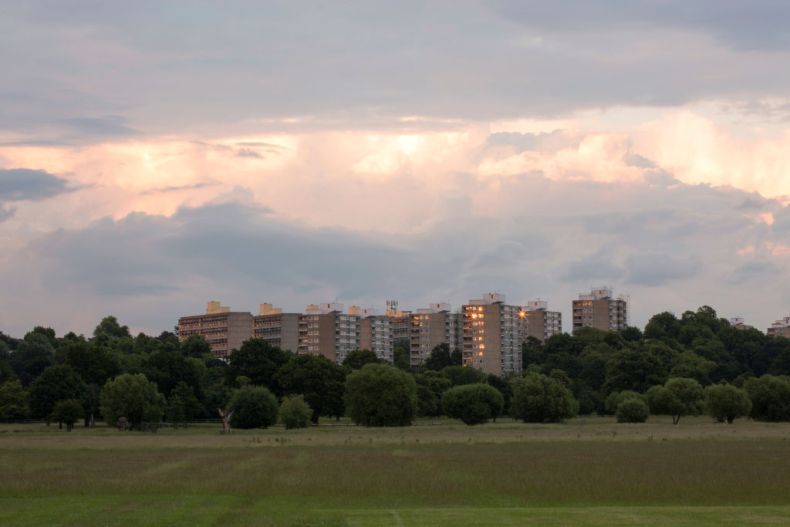The Alton Estate in Roehampton, perhaps the most important complex of 20th-century housing in Britain, is under threat from proposals to demolish the centre of the estate and replace it with a very large, very clashing new development. If it goes ahead the estate, and views from Richmond Park, will be changed for ever.
The estate consists of several thousand flats, maisonettes (two-storey flats), and houses spread artfully over a beautiful green site next to Richmond Park. Commissioned and designed by the London County Council (LCC) in the 1950s as its flagship development, the estate was hailed by the great architectural historian Nikolaus Pevsner as ‘brilliant […] aesthetically the best housing estate to date’, and by G.E. Kidder Smith as ‘probably the finest low-cost housing in the world’. Photos and plans of the Alton were published in journals, which helped to consolidate the LCC’s reputation as one of the most ambitious and innovative city governments in the world during the mid 20th century.
The LCC Architect’s Department was for a time the largest architectural practice on the planet, and the best young architects flocked to work for it. United by their confidence in their collective ability to improve the living conditions of millions of Londoners, they debated and drew, read and researched, visited building sites and material manufacturers, negotiated and organised.
The first phase at Roehampton, Alton East (1952–55) was inspired by the housing estates of Sweden. (The country’s neutrality in the Second World War meant that it had not had the same lengthy suspension of building activity experienced by other European countries.) Alton East dotted taller, slender towers around among terraces and low blocks of two-story apartments, retaining trees from the Victorian gardens of the site. The results were pretty, pleasant, and self-consciously picturesque, taking as their model the English stately home landscaping tradition as opposed to the heavy-handed grids and oppressive regularity that influential English critics, including Pevsner, criticised in continental modernism.
As the estate expanded on to the even larger site of Alton West (1953–61), the architecture also stepped up a notch. Younger, more radical architects got involved, freshly returned from visits to Le Corbusier’s unité d’habitation in Marseille, finished only the year before construction began at Alton West. At Roehampton they turned Le Corbusier’s dream into a reality, building not one unité but six: five of them in a row at the top of the site, the sixth marking the entrance to and centre of the estate. They are sewn together with boldly picturesque landscaping and an exciting variety of other housing types, ranging from tiny, villagey bungalows to long terraces of flats and high towers.
View of Alton Estate from Richmond Park, London. Photo: Sam Mellish/Getty Images

The parkland of the estate itself appears to flow seamlessly into the gardens of a handful of very fine 18th-century houses to one side, and beyond them into a golf course and Richmond Park. Seen in the opposite direction, from the park, most of the lower housing disappears behind the trees, with the groups of taller blocks emerging from what appears otherwise to be Arcadian woodland. The crisp geometries of the light grey towers, rising from the forest to give ordinary Londoners the best views in the city, were and remain the most perfect visual expression anywhere of the ‘new Jerusalem’ of the British welfare state.
On its completion, the Alton Estate was visited by architects, planners, politicians, and commentators from all over the world. Pevsner made the Alton Estate the grand, optimistic climax to his seminal Outline of European Architecture (6th edition; 1960) – the happy outcome of millennia of development through temples, churches, palaces, and station termini. As is usual with modernist council estates, the question of what ‘the residents’ think is hard to assess. Firstly, views are always widely varied, but more than that, they are seldom given a serious hearing. ‘Consultations’ tend to be conducted by interested parties, and to frame discussion in ways which push towards some answers and away from others.
In discussion of modernist housing, solvable problems like single-glazed windows and insulation, which is poor by today’s high standards, are often lumped together with a lingering 1980s hostility to the look of the architecture, and a vague but enduring mishmash of half-remembered claims about crime rates, and scenes from Kubrick’s A Clockwork Orange.
It seems taken as a self-evident truth that modernist housing is unloved and has ‘failed’ – a meaningless tag reserved for post-war housing; who asks if Edwardian or earlier housing is ‘a success’ or ‘a failure’? Even as the threat to postwar estates grows, Londoners who can afford to do so eagerly move into the best estates of the 1950s, ’60s and ’70s, conserving every simple but well-designed original feature they can. With the Alton Estate as with so many others there is no inherent reason why the existing buildings could not be refurbished to a standard that many people would be delighted to live in.
At the heart of the estate, where Alton East meets Alton West, the LCC’s architects carefully tied the new buildings into the ancient High Street of Roehampton Village, adding a library and more shops to the facilities of the High Street at the point where it met the estate. Over the library, Allbrook House, the sixth of the great unités – referred to by its architects as a ‘marker block’ – announces the estate with all the considerable pride and architectural quality the LCC could muster.
Allbrook House and the library, with maisonette blocks over shops to the left. Every building in this photo is proposed for demolition. Photo: James O. Davies/Historic England

The key architects of these finishing touches were John Partridge, one of the team who had designed the other five slab blocks of the estate, and Roy Stout who, like Partridge, was to go on to an important and much-admired career in private practice. The two have an impressive group of later listed buildings to their names. Partridge recalled that the detailing of Allbrook House benefited from the considerable experience they had accumulated by then on the earlier blocks, and was handled with greater skill and greater panache than on the previous slab-blocks.
Stout’s recollections underline the special qualities of Allbrook House: the budget was better than that for the earlier slab blocks (which are listed at Grade II*, making them among the finest 8.3 per cent of all English listed buildings). The increased budget allowed the architects to do things even better than in the earlier slabs. Thus, at Allbrook House, the ends of the blocks are not supported by columns but fly freely out, showing off the tremendous power of concrete and steel. The parapets to the balconies at Allbrook are beautiful pierced concrete like Le Corbusier’s, rather than the cheaper glass of the II*-listed slabs.
The Alton Estate seen from Richmond Park. The red line indicates the eighth floor of the current blocks on the site, the upper number of storeys proposed for the new buildings to replace blocks like those only just visible below it through the trees.

Yet Allbrook House, the library that slides underneath it, and the handsomely tough maisonettes above shops that form a square facing the library, have not been listed by English Heritage (now Historic England) although other comparably important buildings on the estate are deservedly listed. The library has been rather bashed about inside, though it could still be made beautiful for much less than building a new one. Allbrook House’s omission, however, is baffling: it was not some half-hearted afterthought, but rather the carefully orchestrated climax and centrepiece of the entire estate’s development.
Listing was not the only chance of salvation. The Alton Estate has its own conservation area, drawn up by Wandsworth Council. Yet Allbrook House and its neighbours, along with a large area of shabby but thoroughly reparable blocks of maisonettes, were mystifyingly left out of it. The conservation area looks as if it has had two large bites taken out of the estate, one on each side. The result is two very handy parcels of land. The first of these has been inching towards complete demolition and replacement for some years now.The systems put in place to protect our heritage are working increasingly poorly for mid 20th-century heritage and have, it seems to me, reached a point of crisis. For a start, the bar for listing is far higher for this period. When English Heritage last published figures on it, only 0.2 per cent of all listed buildings were begun after 1945, although the proportion of all English buildings constructed in that period is considerably higher than over any other comparable span of decades.
Almost worse than the limited listing of good modernist buildings, however, is the ignoring of expert advice on what to conserve and how to do so. Ministers repeatedly reject the recommendations of their own advisors, Historic England, refusing to list buildings including the South Bank Centre. Historic England’s recommendations themselves sometimes appear to an outsider’s eyes to be inflected by political or other pressure. And the Twentieth Century Society (of which I am a trustee), the leading centre of specialism on buildings since 1914, with its professional caseworkers and its wealth of specialist knowledge and historical understanding, is often consulted, only for its expert advice to be ignored.
The Twentieth Century Society threw its weight behind the listing of Allbrook House and argued for a conservation area that really does embrace the estate as a whole. It has shown considerable flexibility and open-mindedness in discussing how necessary improvements can be made, but its recommendations on what to conserve have simply been sidelined.
Meanwhile Wandsworth Council and the property developers they have brought in, Redrow, have released a master plan for consultation. It is utterly insensitive to the immense heritage importance of the high-quality architecture and planning on the estate. Wandsworth Council’s own documents are strikingly thin on acknowledgement of the importance and quality of the LCC’s architecture on the estate, and Historic England is failing to raise an objection to the mass demolitions.
Plan showing the proposed heights of the new buildings on the Alton Estate. Wandsworth Council

The proposed replacements for the lost heart of the estate are only at outline stage so far, but a massing drawing suggests that from Richmond Park the new buildings would appear as an almost continuous wall of ‘six to eight storey’ flats (up to twice the height of almost all the present unremarkable but pleasant flats on the site), filling an area that, from the park, currently appears to be dominated by trees. The density, size and planning of the proposed blocks is entirely out of keeping with the two ends of the estate that would survive, and would forever divide them, destroying their character as a single vast showpiece of innovative housing and great architecture. It was the overall size of the estate that Pevsner identified as a key source of its greatness: ‘If the total effect is superior to any in Sweden [high praise in the 1960s], the reason is scale… Scale helps to create the satisfactory unity-in-variety.’
Who knows what mixture of motives the council has in pushing through the vast ‘regeneration’. Some of those involved may still cleave genuinely to the view that modernist architecture is intrinsically problematic, and that any social problems experienced on the estate are the results of the architecture rather than of the differences in income and opportunities between the social housing tenants and the owner-occupiers of the £1,000,000+ houses that make up so much of the rest of the borough. With only 188 units of social housing planned for the new blocks, the 1,000 new properties of the proposed replacement would certainly represent a major change in demographics.
The demolition of the heart of the Alton Estate, and its unsuitable replacement, is looking increasingly inevitable – and imminent. Having grown up near the estate, and living now in Wandsworth, I find it particularly heartbreaking. The fact that the architecture is only 60 or so years old must not be allowed to cloud the vast historical significance of an estate which, for a few more precious months, remains unusually well-preserved and unified. You can still see it today largely as its world-leading team of architects originally intended. Many of our great Victorian buildings were only saved from demolition in the 1950s and 1960s by growing public pressure for conservation. If we do not move fast, much of our best 20th-century heritage will be lost or irretrievably marred.



